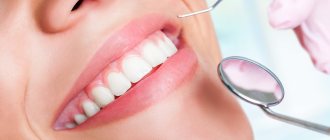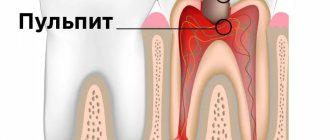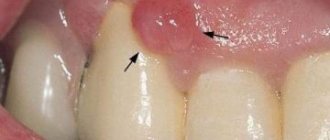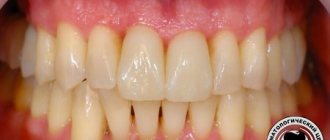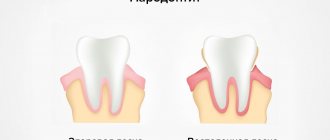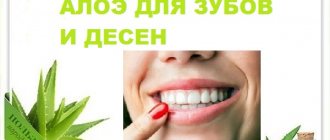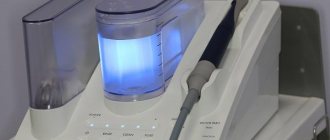- Targeted exposure Drugs are selected individually after culture analysis for anaerobic microflora
- An integrated approach to the solution We not only treat periodontitis, but restore the health of the entire body
- Guaranteed results Results are noticeable within 7 days, visible guaranteed percentage of improvements - 60-80% in the first year
- Transparency All manipulations and medications are included in the package offer
Victoria, 54 years old
“I went to the clinic with a problem - the initial stage of periodontitis. The treatment was carried out by Dr. Marina Igorevna Tarabanovskaya. I had closed curettage, plasma lifting, laser, and injections with hyaluronic acid. I got tangible results after just 3 visits!”
- guaranteed result
- healthy gums
- nutrition without pain and discomfort
- restoration of up to 80% of destroyed tissues
watch a video with the patient
Why does periodontitis need to be treated only comprehensively?
The insidiousness of periodontitis lies in its chronic nature and the fact that in fact the infectious process is very difficult to eliminate. Inflammation affects the gums, periodontium and all periodontal tissues, that is, also bone tissue. Therefore, if you simply remove plaque and stone, but do not completely eliminate the source of infection, the process will continue. If, in addition to hygiene, you add drug therapy, rinses or injections, you can block the development of infection, but the damaged tissue will remain in the same condition in which you went to the doctor.
That is, in order to stop inflammation and restore damaged tissue, you really need to make a lot of effort - and this will help with comprehensive programs that have been developed by experienced periodontists at the Smile-at-Once clinic for patients with various stages of periodontitis.
Periodontitis is a dangerous disease! It leads to loss of teeth, as well as disruption of the functioning of many organs: heart, kidneys, and gastrointestinal tract. Find out more about why periodontitis is dangerous for your body.
What is periodontitis?
Periodontitis, or, as it is popularly called, dental periodontitis, is an inflammatory disease of the periodontal tissues that surround the tooth (gums, dental ligament and surrounding jaw bone). In professional terms, periodontitis is an inflammation of the ligaments of the tooth.
Periodontitis can be localized, that is, spread to the area of one or two teeth, or generalized, that is, affect most of the dentition. If a patient has periodontitis, it is usually chronic. Therefore, the main task of a specialist is to identify the cause of the disease, prescribe the correct treatment and, most importantly, prevent subsequent exacerbations and complications.
What results can we achieve?
If the treatment is carried out in combination, then all the factors that cause inflammation and relapse of the disease are removed along the chain. The jaw system begins to function fully, metabolic processes improve, and the tone and immunity of the gums increases. And by replenishing the lost tissue volume, the appearance of both the teeth and the mucous membranes around them is completely restored.
- preservation of teeth: the ability to stop the disease and stop the spread of infection,
- restoration of aesthetics: the health and appearance of the gums will improve, recession will be reduced without plastic surgery, the gaps between teeth will disappear, the height of the crowns will decrease to normal sizes,
- relief of inflammatory processes in periodontal tissues, antibacterial and antiseptic treatment, elimination of the source of infection and bad breath,
- creating a favorable environment for the restoration of the jaw bone and ligaments that hold the tooth in the socket - replenishing up to 80% of the volume of destroyed tissues,
- preventing tooth mobility and bone atrophy,
- the ability to place implants to replace missing teeth without the risk of rejection, even in the presence of periodontitis,
- improvement of the whole body by eliminating the source of infection from the oral cavity, normalizing nutrition,
- stable results in the long term.
A diagnosis of periodontitis of mild or moderate severity can be treated and stabilized. The latest approaches in periodontology and the use of biological products with growth factors make it possible to restore tooth cement, lost periodontal ligaments, soft tissues and bone. And even carry out implantation without risks due to periodontitis (now former).
Each stage of periodontitis has its own comprehensive approach!
Stage I treatment “Recovery”
restoration of soft tissues, maintenance of periodontal health. 50,000 rub.
Stage II treatment “Persistent remission”
elimination of inflammation and tissue restoration, achieving stable remission. 140,000 rub.
Stage III treatment “Rescue and Preservation”
intensive restoration of soft tissues and bones, preservation of teeth. 220,000 rub.
What consequences can untreated periodontitis lead to?
Loss of teeth
The advanced stage of the disease destroys the soft and hard tissues around the teeth, which leads to their loss.
Deterioration of conditions for implantation
As mentioned earlier, with severe periodontitis, the volume of the jaw bone is significantly reduced, which makes it difficult to install implants, requiring preliminary bone growth, and in extremely severe cases makes implantation impossible.
The occurrence of other diseases
Periodontitis contributes to diseases of the gastrointestinal tract, diseases of the lungs, heart and even the formation of blood clots.
How long will the treatment take?
Each stage of periodontitis has its own comprehensive solution. But each course lasts at least a year. On a monthly basis, you will need to visit your attending physician - a periodontist, who will monitor the progress of treatment, select/prescribe medications, evaluate the effectiveness, and, if necessary, make adjustments to achieve a better result.
In a year, after re-diagnosis, it will be clear whether it is possible to limit ourselves to maintenance therapy or whether a course of treatment will be required again, only a simpler one. But based on our practice, at stages I and II of periodontitis, with careful implementation of all recommendations on the part of the patient, it is more than possible to transfer the disease into remission and even completely get rid of it in 1 year.
What patients say about treatment
Alena Borisovna After periodontal treatment. Ahead – dental implantation
Elena Aleksandrovna With words of gratitude for the high quality!
Elena Ivanovna After periodontal treatment Smile Recovery
Olga Vasilievna After periodontal treatment
Elena Yurievna At the start of periodontal treatment Smile Recovery
Hayk Samvelovich After removing braces and periodontal treatment Smile Recovery
Alina Andreevna After treatment of caries and periodontal complexes Smile Recovery
Kirill Yurievich At the stage of preparation for dental implantation
Tatyana Aleksandrovna After periodontal treatment Smile Recovery
Olga Anatolyevna After complex treatment of periodontitis
Svetlana Aleksandrovna With words of gratitude for the careful and painless treatment!
— After periodontal treatment. Ahead – dental implantation
With one of the attending physicians, dental therapist, periodontist Marina Tarabanovskaya - after successfully completed periodontal treatment within the unique Smile Recovery complexes. The next stage of a comprehensive smile transformation for our patient will be implantation, for which she has undergone thorough preparation.
Alena Borisovna
After periodontal treatment. Ahead – dental implantation
Doctor: Specialization: Experience:
from 3 months
View all reviews
— With words of gratitude for the high quality!
Our patient Elena Aleksandrovna with one of the attending physicians - implant surgeon, periodontist Valentin Kurbatov - after undergoing a unique complex treatment of periodontitis Smile Recovery to restore the condition of the gums.
Elena Alexandrovna
With words of gratitude for the high quality!
Doctor: Specialization: Experience:
from 3 months
View all reviews
— After periodontal treatment Smile Recovery
With the attending physician - dentist-therapist, periodontist Marina Tarabanovskaya. Smile Recovery periodontal complexes allow you to cope with inflammation, bleeding and sore gums, restore and strengthen periodontal tissue. And healthy gums, in turn, help preserve teeth and maintain a healthy microclimate in the oral cavity.
Elena Ivanovna
After periodontal treatment Smile Recovery
Doctor: Specialization: Experience:
1 year
View all reviews
— After periodontal treatment
Taking care of gum health is the key to successfully preserving your natural teeth. Our patient Olga understands this very well, and therefore undergoes periodontal treatment from a dental therapist, periodontist Marina Tarabanovskaya.
Olga Vasilievna
After periodontal treatment
Doctor: Specialization: Experience:
from 1 hour
View all reviews
— At the start of periodontal treatment Smile Recovery
The health of your gums directly affects the condition of your teeth. And our Smile Recovery periodontal complexes help get rid of inflammation. Periodontist Marina Tarabanovskaya carries out gentle procedures to save gums and teeth with her sensitive hands.
Elena Yurievna
At the start of periodontal treatment Smile Recovery
Doctor: Specialization: Experience:
1 year
View all reviews
— After removal of braces and periodontal treatment Smile Recovery
With the attending physicians: orthodontist Zakir Vagapov - after successfully completed orthodontic treatment with braces, as well as implant surgeon Aida Dzhutova and periodontist Marina Tarabanovskaya after therapeutic and periodontal treatment with Smile Recovery.
Hayk Samvelovich
After removal of braces and periodontal treatment Smile Recovery
Doctor: Specialization: Experience:
from 6 months
View all reviews
— After treatment of caries and periodontal complexes Smile Recovery
After treatment of caries - with the attending physician, dentist-therapist Olga Belyaeva, and also a year later - with Marina Tarabanovskaya, who provides the patient with complex periodontal treatment Smile Recovery.
Alina Andreevna
After treatment of caries and periodontal complexes Smile Recovery
Doctor: Specialization: Experience:
from 1 hour
View all reviews
— At the stage of preparation for dental implantation
After examination, consultation and professional oral hygiene with a dentist-therapist, periodontist Marina Tarabanovskaya. Our immediate plans include undergoing periodontal treatment using our unique Smile Recovery complexes.
Kirill Yurievich
At the stage of preparation for dental implantation
Doctor: Specialization: Experience:
from 2 months
View all reviews
— After periodontal treatment Smile Recovery
Our patient with her attending physician, periodontist Marina Tarabanovskaya, after undergoing complex periodontal treatment with Smile Recovery before dental implantation.
Tat `yana Aleksandrovna
After periodontal treatment Smile Recovery
Doctor: Specialization: Experience:
from 3 months
View all reviews
— After complex treatment of periodontitis
With periodontist Marina Tarabanovskaya - after complex periodontal treatment Smile Recovery before preparing for dental implantation.
Olga Anatolyevna
After complex treatment of periodontitis
Doctor: Specialization: Experience:
from 3 months
View all reviews
— With words of gratitude for the careful and painless treatment!
Svetlana Alexandrovna is undergoing complex treatment in our clinic. She started with Smile Recovery periodontal complexes, then - treatment and restoration of teeth. In the photo - with the attending physicians, periodontist Marina Tarabanovskaya and therapist Maria Khvorost.
Svetlana Alexandrovna
With words of gratitude for the careful and painless treatment!
Doctor: Specialization: Experience:
from 1 hour
View all reviews
Natural rinses
Decoctions and infusions of medicinal herbs and plants will be excellent helpers in the fight against periodontitis. For a therapeutic effect, you should rinse your mouth with fresh infusions up to 4-6 times a day. Here are the most popular recipes.
- Walnut leaves.
Pour 2 teaspoons of leaves into a glass of boiling water, leave for an hour, strain. You should rinse your mouth with the resulting warm infusion up to 6 times a day. - Oak bark
, linden blossom. 20 grams of dry plants should be poured with 1 glass of boiling water and left for 1 hour. You should rinse your mouth with the resulting mixture up to 4 times a day. - Blackberry leaves
, St. John's wort. To create a decoction, pour 3 tablespoons of the dry collection with 1 cup of boiling water and leave the mixture for 2 hours. Then the mixture should be strained, poured into a thermos and rinsed with the resulting warm mixture twice a day. - Calamus root.
To create this very effective rinse, add 0.5 liters of vodka to 100 grams of calamus root and leave the mixture for 2 weeks. Pour 20 grams of propolis into another container and also add 0.5 liters of vodka. The mixture of these two components is infused for two weeks; the resulting composition should be rinsed in the mouth for 2-3 minutes for a month. - Pine rinse.
To prepare it, add 2 tablespoons of washed pine needles to two glasses of water. The infusion should be brought to a boil and simmer over low heat for 5 minutes. The decoction should be filtered from the remaining pine needles and used 3 times a day.
Compotes made from cranberries, lingonberries, raspberries, and rose hips will help saturate your gums with useful components and strengthen them. They can also be used to rinse your mouth (up to 4 times a day) or drink in concentrated form in the morning on an empty stomach for 2-3 weeks.
It is important to rinse your mouth with periodontitis with compositions at room temperature. Too cold or hot mouthwash causes cracks in tooth enamel and mucous membranes.
So, now you know which rinses will be effective for periodontitis. Take care of your gums and remember: it is impossible to cure periodontitis solely with rinses. The disease requires careful attention and comprehensive treatment prescribed by an experienced dentist.
How periodontitis is treated: what is included in the comprehensive Smile Recovery programs
We have studied the international experience of recent decades in the field of periodontology, selected the most effective methods and combined them into thoughtful treatment complexes. This has taken periodontitis treatment at Smile-at-Once to the next level. The goal is not only to eliminate symptoms and stop the disease, but also to reverse the destruction of periodontal tissues.
- comprehensive diagnostics, images, tests and microflora cultures,
- professional 5-step oral hygiene,
- gum curettage (open or closed) with laser and aqua-abrasive treatment of tooth roots,
- splinting of teeth,
- plasma lifting or the use of APRF membranes,
- periodontal dressings, a course of injection therapy with individually selected drugs,
- replenishment of gingival tissue volume with Straumann Emdogain® containing natural growth factors,
- replenishment of bone volume with BoneCeramic®, Bio-Oss® or Creos™,
- training in proper self-hygiene and an individual set of personal products (toothpaste, brush, mouthwash, gum gel, dental floss and portable irrigator),
- monthly observation by a periodontist for 1 year.
We treat periodontitis for sure and with a guarantee! We have developed complexes that will definitely help you. A beautiful smile, healthy teeth and gums await you!
Enroll now
What are the causes of periodontitis?
Understanding the causes of the disease is a very important point, which helps the doctor correctly determine how to treat gum periodontitis. The disease can be triggered by both general and local factors. Common causes include diseases of the gastrointestinal tract, diseases associated with pathology of the endocrine system, some gynecological and urological diseases, sexually transmitted infections, and a weakened immune system. Local, or local, factors are missing teeth, malocclusion, incorrectly installed fillings or crowns, which mechanically irritate the gums and create conditions for the accumulation of bacterial plaque. A significant role is played by the specific microbial flora of the oral cavity, which occurs in some patients and causes periodontitis. But the main factor in the development of periodontitis is poor oral hygiene.
Comprehensive examination and diagnostics
- goal: determining the stage of periodontitis, choosing drugs for precise impact,
- Frequency: 2 times a year - before the start and to monitor the results of treatment.
Before starting treatment, it is very important to assess the degree of destruction of bone tissue, identify the specific causative agent of the inflammatory process, and also understand what exactly provokes the development of periodontitis - dental plaque or systemic problems of the body.
Quality diagnostics include:
- examination by a doctor, assessment of the depth of periodontal pockets and the amount of deposits on the teeth,
- collecting anamnesis and medical history, talking with the patient about how hygiene is carried out, what products are used, when problems with gums appeared and what methods of solving the problem were used previously,
- computed tomography (CT) to assess the degree of destruction (destruction) of bone tissue,
- microbiological examination of the contents of gum pockets for anaerobic microflora and sensitivity to drugs - it is important for the doctor to understand what drugs you need to prescribe so that they are as effective as possible,
- general blood test + blood sugar level, if necessary - tests for hormone and vitamin levels. This is important to clarify the cause of the development of periodontitis. And again for prescribing treatment.
Sowing for microflora is also done 2 times a year - before and after treatment. First, this is necessary to select a narrowly targeted effective medicine against the causative agent of inflammation, and after the course - to monitor whether the pathological activity of bacteria is suppressed.
Read more about periodontal diagnostics in a separate article on our website.
Professional deep cleaning of teeth and periodontal pockets
- goal: removal of plaque, stone and bacterial film that provokes their appearance,
- Frequency: at least 2 times a year.
This stage precedes all other methods of treating periodontitis. The hygienist removes microbial biofilm in the form of plaque and hard tartar - these are the factors that lead to primary gum inflammation. Multi-stage cleaning consists of five stages:
- ultrasonic and/or laser cleaning to remove dental plaque,
- treatment of the tooth surface and removal of pigmented plaque using the Air-Flow air-abrasive system,
- polishing with a brush and antiseptic paste to prevent the accumulation of dental plaque,
- strengthening enamel with fluoride gel,
- Strengthening gums with special membranes containing medications.
During the cleaning process, the depth of periodontal pockets is reduced, supragingival and subgingival tartar, granulations and infected connective tissues that accumulate on the surface of the teeth and under the gums at a depth of no more than 3 mm are removed.
What complications can there be?
Doctors consider periodontitis one of the most difficult diseases of the oral cavity, largely due to possible complications. Untimely treatment can lead to damage to the respiratory tract and endocrine system, and the appearance of cardiac pathologies. The inflammatory process leads to the formation of cytokines, which, when entering the body, interfere with insulin production. This becomes the cause of diabetes.
Periodontitis also affects the cardiovascular system, increasing the risk of stroke and heart attack. The disease can provoke enterocolitis, an imbalance of microflora in the intestines, and gastritis.
Splinting mobile teeth
- goal: strengthening teeth that have become mobile (even unobvious micromobility beyond the norm is already a great danger of violating the integrity of the dentition),
- frequency: the tire is installed on an ongoing basis.
If nothing is done, the loosening of teeth during periodontitis becomes avalanche-like. Due to the destruction of the ligamentous apparatus, as well as a reduction in the volume of bone tissue, the teeth gradually become noticeably mobile, because It’s already difficult for them to stay in the holes; they shift, tilt or fan out.
During splinting, mobile teeth are combined into a group with relatively healthy ones using an aesthetic thread - it is called a splint. It can be reinforced (gray metal) or fiberglass (white). The splint is fixed on the inside of the teeth and will be invisible.
Splinting itself does not save you from periodontitis, because if you do not carry out therapeutic treatment, mobile teeth will fall out along with the splint. Often the teeth are held in their sockets by the presence of a large amount of stone - if it is removed immediately, the teeth can be lost. Therefore, the splint is always placed BEFORE deep cleaning of the teeth in case of heavy tartar and gum recession.
If part of the teeth in a row is missing, it is possible to manufacture and fix a removable splinting clasp denture. However, it often disables the teeth on which it rests, which can lead to their loss too early.
Closed or open gum curettage
- purpose: to remove granulations that are located deep under the gums,
- Frequency: once, as needed.
Curettage is a surgical operation in which the doctor penetrates deep under the gum to a depth of more than 3 mm with special instruments (curettes) and removes deposits (plaque and tartar) that are localized on the tooth roots. Unlike regular cleaning, it may be accompanied by an incision, that is, peeling of the gums from the surface of the teeth - the doctor needs access to all deposits. This type of cleaning is called deep cleaning. Read more about how curettage is performed and how the closed type differs from the open type.
Let us repeat that in stage II and III periodontitis, splinting is carried out BEFORE deep curettage of the gums. Otherwise, there is a danger that after removing deposits, some teeth may fall out of their sockets. In the later stages of the disease, essentially only tartar holds the teeth in the oral cavity, while further destroying the bone tissue of the jaw.
Smile-at-Once dentistry also uses a gentle method of removing granulation tissue with a diode laser. Only the affected tissues are affected, while simultaneous antiseptic treatment occurs. Healthy tissues are strengthened, the vessels are “sealed”, due to which bleeding practically does not occur, and therefore the risk of pathogenic microflora entering the blood is reduced.
Classification
Types of periodontitis differ in the severity of symptoms, their severity, pain, complications and consequences. In each case, the doctor must determine the form and degree of the disease in order to correctly prescribe treatment.
- Based on how the pathology proceeds, we can distinguish:
- An acute form, in which the rapidity of tissue infection can lead to serious manifestations in a short period. Bleeding and pain, early appearance of abscesses and even the formation of fistulas can appear in just 1-2 months. This is a fairly aggressive form of periodontitis that cannot be ignored.
- Chronic, when the symptoms are not particularly pronounced and the course is sluggish. In this case, the disease may not cause severe suffering to a person, but damage and tissue destruction still occurs.
It is characteristic that with a rapidly progressing form of periodontitis, the patient is most interested in receiving professional help to alleviate the condition. In the chronic phase, it is easy to start the disease and lead it to more serious pathologies, which will be extremely difficult to cure.
- If we talk about the location of the infection and its prevalence in the oral cavity, then we should distinguish:
- Localized or focal variant. It occurs, most often, from mechanical damage to a small area of soft tissue. At the same time, it can be cured quickly and easily.
- Generalized – widespread throughout the periodontal area. It is this variant of the disease that is characteristic of a bacterial infection and with low human immunity, when the body itself cannot fight the active growth of pathogenic bacteria.
- The severity of periodontitis leads to a variety of lesions, and the longer this disease is ignored, the more difficult the symptoms and its treatment will be:
- A mild stage, when the pathology does not take serious forms. The patient often pays attention only to bleeding gums and some unpleasant sensations while brushing his teeth. This initial stage involves the appearance of periodontal pockets of a minimum size, up to 3 mm, and the destruction of bone tissue is no more than a third of the root unit.
- Moderate severity is characterized by wide gaps in pockets that reach 6 mm, and the destruction of the root covering affects half of its size. In addition to bleeding and pain, teeth may begin to loosen. Doctors note the presence of stromal sclerosis and granular tissue.
- A severe degree of the disease is manifested by rapid deformation of the interdental septa, collapse of collagen fibers, and destruction of most of the root tissues. Periodontal pockets become especially voluminous - more than 6 mm. Remains of food that penetrate into them quickly lead to purulent processes, and teeth may begin to fall out.
It should be noted that even with complex treatment and good results, it will be almost impossible to fully restore damaged tissue, especially if the disease has reached severe forms.
In addition to this classification, doctors also distinguish abscess, marginal and necrotic periodontitis. For the most part, these are simply complex manifestations of advanced forms of the disease that have particularly pronounced symptoms.
Thus, the abscessed variant indicates abundant purulent discharge, the necrotic one indicates tissue death, and the marginal one is just a localized superficial form of initial periodontitis.
Diode laser therapy and teeth cleaning
- purpose: antiseptic treatment of gums, activation of regenerative functions and removal of deposits,
- Frequency: as needed, in conjunction with gum cleaning/curettage.
Laser treatment of the surface of teeth (including roots), as well as gums, is combined with comprehensive cleaning or curettage of the gums. The laser removes pathogenic microflora, soft and hard deposits, activates the regeneration of soft tissues and the growth of new cells, increases the tone and resistance of the gums to the activity of pathogenic bacteria. Under the influence of a beam of laser beams, water breaks down into hydrogen and oxygen, which destroys the cells of pathogenic microbes and hard plaque, disinfects surfaces and creates favorable conditions for further treatment.
Is it possible to eliminate periodontitis with a laser?
Laser treatment of periodontitis is one of the most effective and minimally invasive ways to combat the disease, which is one of the stages of complex treatment. The laser has cleansing and antibacterial properties. During the procedure, each periodontal pocket is treated for a certain time, sufficient for the laser light beam to destroy pathogenic bacteria. The procedure is bloodless and virtually painless. However, a good effect can only be obtained with an integrated approach to the treatment of periodontitis.
Biologically active preparations for tissue restoration
- goal: restoration of the volume of bone and gum tissue.
- Frequency: 1-2 procedures.
With the advent of nano- and bioactive materials that stimulate the regeneration of one’s own cells due to the content of growth factors, it has become possible to restore the volume of destroyed tissues at the initial and moderate, and sometimes even at the severe stages of periodontitis. With a favorable prognosis, recovery is up to 80%, and we are talking not only about gum tissue, but also about bone tissue.
In this case, only 1-2 procedures are enough, and the process itself will continue for many months (and even years).
A biogel based on a mixture of enamel matrix proteins, which is produced by Straumann under the name Emdogain®, is used during gum curettage - applied around the roots of the teeth after gum peeling or inserted with a special nozzle into deep gum pockets without peeling. For bone tissue, other products are used, such as BoneCeramic® or Bio-Oss® from Straumann. Additionally, barrier membranes are used (for example, collagen Creos™ from Nobel), which serve as a barrier against the entry of pathogenic microbial environments during the period of active restoration and strengthening of one’s own bone cells and periodontal tissues.
These drugs are not commercially available - their use is permitted only under the supervision of a specialist. They are quite expensive, but they are the only ones that truly restore damaged tissue. For example, the effectiveness of Emdogain® has been proven in more than 200 publications based on data from 40 international clinical studies. Over the course of 10 years, 1500 intraosseous periodontal defects were studied.
Data from international studies confirm: after using drugs with growth factors, the depth of the periodontal pocket decreases by almost 5 mm after 1 year, that is, the defect is filled by 74% with healthy tissue. As for bone tissue, after a year the increase is 70%, over 10 years - up to 93% after treatment1.
The results of other studies, as well as more details about the use of materials with growth factors, are in our separate article.
Plasmolifting and the use of APRF membranes
- goal: accelerating the process of tissue repair, relieving inflammation, increasing gum immunity,
- frequency: course of 3-5 procedures.
Plasmolifting, like bioactive drugs, is used as the main therapy for the restoration of all periodontal tissues. It is used in periodontics both in the form of membranes (in particular, for gum curettage) and in the form of injections. The patient's own blood plasma, rich in platelets, is used. These are cells that promote rapid tissue repair.
Plasma is a natural and safe immunomodulator; it is injected into problem areas, relieves inflammation and stimulates rapid tissue regeneration.
Plasma is obtained directly from the patient. First, blood from a vein is taken into a special tube with an activator. Afterwards it is placed in a centrifuge, where the blood is divided into fractions: depleted and enriched plasma, fibrin and other components. Depending on the method of therapy, plasma is prepared for injection or a fibrin clot is a membrane that is applied to the affected tissue.
Drug and injection therapy
- goal: restoring nutrition, saturating cells with oxygen, relieving inflammation,
- Frequency: course of 1-5 procedures (depending on the drug).
In addition to platelet blood plasma, therapeutic bandages with a cooling and regenerating effect, injection courses of vitamins or medications are added to enhance the therapeutic effect. If there is a need, the patient is also prescribed antibacterial drugs - but not a broad profile, but a targeted effect on the causative agent of the inflammatory process. Culture data helps us with this - the analysis is performed at the stage of primary diagnosis.
Application of hyaluronic acid
- goal: restoring the nutrition of gingival tissue cells, increasing resistance, replenishing the volume and water balance of the gums
- Frequency: injections in a course of 1-5 procedures as needed.
Hyaluronic acid is a natural component of connective tissue. It has many important biological functions. It increases tissue elasticity and resistance to external influences, supports metabolic processes, promotes cell regeneration, and suppresses inflammation. As part of the treatment of periodontitis, it is used as injections into the gums to improve their condition.
For maintenance therapy, we use dental preparations Revident and Revident+ - these are hyaluronic injectable gels that are injected under the mucous membrane, stimulating the natural renewal of the protective and retaining functions of the periodontium. The drugs are used simultaneously, restore natural microcirculation, and effectively relieve inflammation2 in combination with other measures. In addition, they increase the tone of the gums, restore volume (remove recession), and are antioxidants.
Important! The doctor alone will not be able to cope with the problem of periodontitis, no matter how excellent the remedies are used. Your attitude to fight and work is very important. Periodontitis is a complex disease, and it takes effort to cure it. Strictly follow all prescriptions at home, as well as strengthen oral hygiene.
How much does it cost to cure periodontitis? What does the cost consist of?
The price for periodontitis treatment depends on the complexity of the disease, whether surgical procedures will be performed and to what extent.
Important!
Folk remedies in the form of all kinds of herbal infusions do not help with periodontitis. They can bring temporary relief and mask the problem, but mouth rinses cannot radically solve it. Neither home treatment nor the miraculous toothpaste from TV commercials will help get rid of periodontitis. Rinses and toothpastes are just one of the auxiliary components in complex treatment. If you have periodontitis or suspect it, contact the dentist for timely diagnosis, since it is in the early stages of the disease that doctors have a lot of opportunities to help you!
